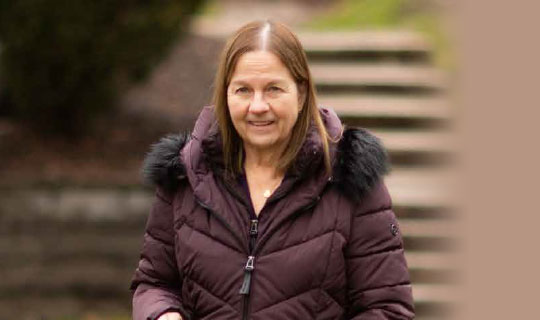“Before the surgery, I was trying to put on a happy face,” she says. “Now, I am truly happy. I feel good inside and out.”

A pioneering endoscopic spine surgery gets a Springfield woman moving again.
She might be retired, but Lisa Gergen’s to-do list never ends. From playing golf with her husband, Stan, to walking her dog, Roxie, Lisa loves staying active. That’s why she was devastated to wake up one morning last year and feel a burning sensation in her lower back. “I could barely get out of bed,” she says.
Lisa tried to remember whether she had done anything to hurt her back the day before. “I had been on my hands and knees doing household chores in the kitchen, and I had changed a few pots in a window box,” says Lisa, 60, of Springfield Township. “But that was nothing unusual for me.”
What followed was months of doctors’ visits, conservative treatments and additional pain. She completed physical therapy and tried prescription muscle relaxers and anti-inflammatory medications, but they didn’t help. Neither did a series of cortisone injections. Along the way, she developed pain around her right hip, then experienced pain down her right side.
“Those pains came and went, but the burning across my lower back never left,” Lisa says. The pain affected her both physically and mentally. She couldn’t sit for more than 30 minutes at a time. She had to stop going to the movies and church. She even lost 13 pounds because the pain had taken away her appetite.
“I was tired of being tired,” Lisa says, “and tired of being in pain.”
An Innovative Treatment

Lisa’s primary care doctor recommended that she see John Shin, MD, an orthopedic surgeon with Jersey City Medical Center (JCMC) and Cooperman Barnabas Medical Center, and a member of RWJBarnabas Health Medical Group. “Two of my doctors highly recommended him,” Lisa says. “Plus, I liked that he worked at JCMC, where my husband and I had received care before.”
As soon as Dr. Shin walked into the office for her first appointment, Lisa felt at ease. “He was extremely thorough and spent a full half hour going through things,” she says. “I never felt rushed.”
Dr. Shin ordered an MRI that revealed the root cause of Lisa’s concerns: Her lumbar spine had a herniated disk, a condition in which rubbery tissue between vertebrae in the spine slips out of place and puts pressure on nerves. Dr. Shin considered the options for treating Lisa’s pain. “One was traditional open surgery,” he says. But Dr. Shin was qualified to offer a second option as well: a new type of endoscopic spine procedure called unilateral biportal endoscopy (UBE) that is performed by only a handful of surgeons in the Northeast. Dr. Shin was the first in New Jersey to perform this procedure, in December at JCMC.
“The UBE approach is ultra-minimally invasive,” Dr. Shin says. “As a result, patients have much less pain, less blood loss and a very minimal risk of surgical site infection. They can get back to doing what they love to do faster.”
The procedure was perfected in East Asia and first used by East Coast surgeons in 2022. Dr. Shin received UBE training from specialists at NYU Langone Orthopedic Hospital and also spent a month in South Korea, where he learned UBE techniques alongside the procedure’s pioneers.
After Dr. Shin explained Lisa’s options, she chose UBE, which would make her one of the first in New Jersey to benefit from the procedure. “It was very appealing to me because there would be less scarring and I would be able to recover sooner,” she says.
Planning a Mobile Future
Dr. Shin performed the UBE procedure at JCMC in December. He made two tiny incisions, each only about 7 millimeters long. Then he inserted a high-definition endoscope—a small tube with a light and camera—through one incision, guiding surgical instruments through the other. The endoscope gave Dr. Shin a clear, magnified view of the spine and neural elements, helping to enhance accuracy and precision.
As soon as Lisa woke up from the surgery, she could tell a big difference.
“I didn’t have any burning in my lower back and leg at all,” she says. She returned home the same day and was able to stop using her prescription pain medication and switch to acetaminophen within two weeks.
Lisa’s results are typical of what patients can expect from UBE, Dr. Shin says. In addition to removing herniated disks, UBE can treat spinal stenosis, a narrowing of the spinal canal, and spondylolisthesis, a condition in which a vertebra moves out of place. “I believe UBE will be the standard of care for these conditions within the next five to 10 years,” Dr. Shin says.
Just two weeks after her surgery, Lisa felt well enough to visit family in Philadelphia, stopping every 30 minutes to stretch, per doctor’s orders. “In six weeks, I was back to doing basically everything,” she says. That includes taking Roxie for daily walks. Next up: a trip to Bermuda, where Lisa plans to do some snorkeling.
In addition to being glad the pain is gone, Lisa is thrilled to have regained her mental well-being. “Before the surgery, I was trying to put on a happy face,” she says. “Now, I am truly happy. I feel good inside and out.”
Learn more about innovative spine care at RWJBarnabas Health.
